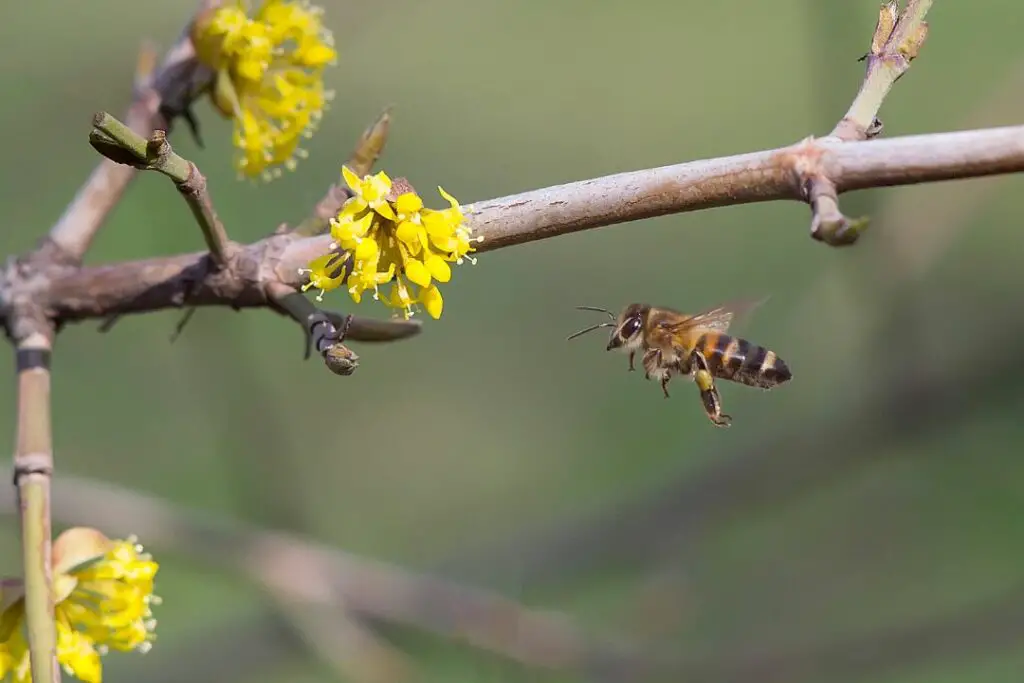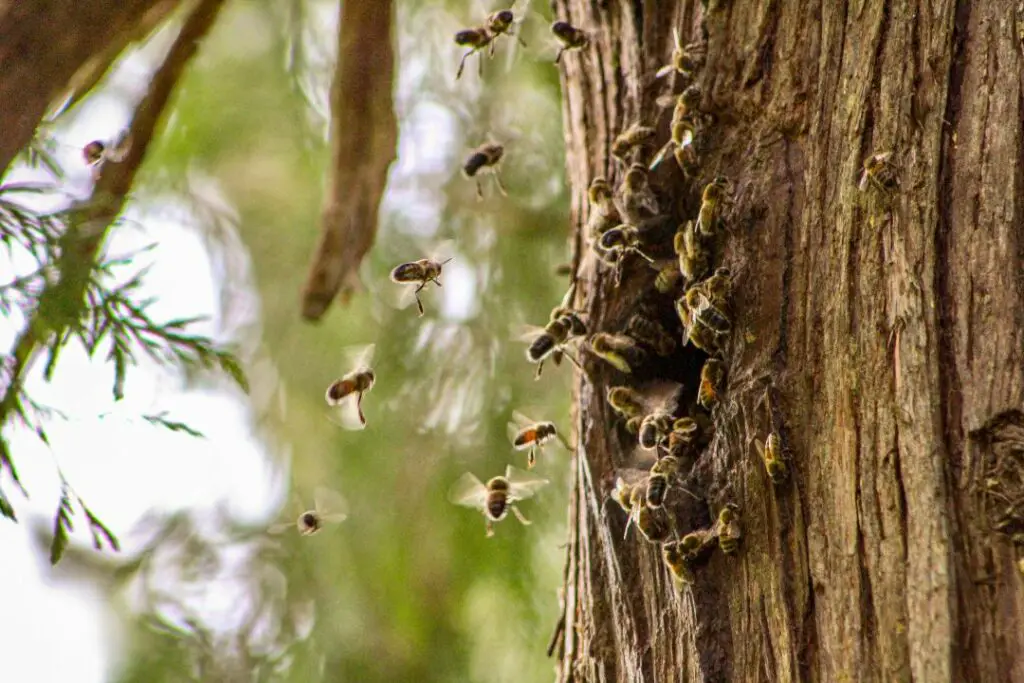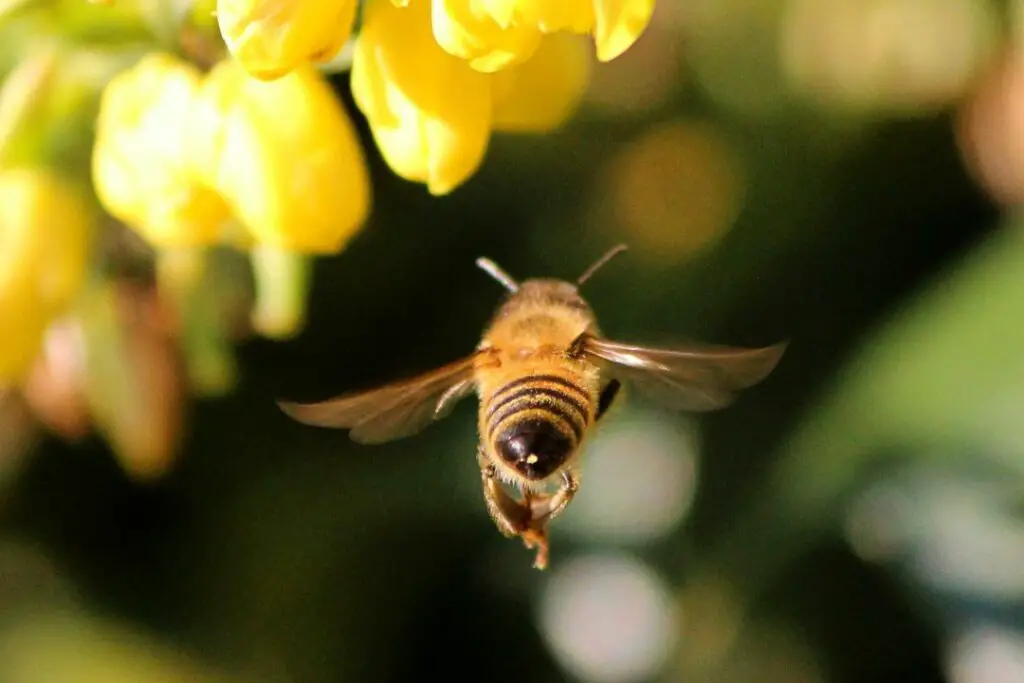Scout bees are mature female honey bees that help to direct the swarm to a new home. They’re elite foragers with a good understanding of the local area and excellent flying skills.
But finding a new nest site isn’t easy. They must search, return and communicate their findings for the colony’s survival.
We’ll fly alongside these explorers to discover more about scouting behaviour and what makes these bees unique.
The Role Of A Scout Bee
Scout bees are the vanguard of the honey bee colony, crucial for survival and growth.
When a colony becomes too crowded, these pioneers kick-start the swarming process—nature’s way of colony reproduction.
Bee swarms are a fascinating spectacle where thousands of bees follow the scouts searching for a new home.
Preparing For The Swarm
Swarming is how bees expand and create new colonies.
Scout bees are the first to sense when it’s time to swarm. Usually, the colony outgrows its current hive or when resources become scarce.
Before the swarm leaves the hive, our bees are tasked with finding suitable new sites for the colony.
Triggers
- Seasonal Timing: Swarming generally happens in spring when flowers bloom, providing ample forage for the new colony.
- Colony Size: A significant increase in the colony’s population is a common trigger.
- Environmental Conditions: Favorable weather conditions are crucial. Ideal conditions for swarming include warm temperatures and gentle breezes.

How Do Scout Bees Find A Nest?
House-hunting scouts are the ultimate real estate agents of the insect world.
Their search for the perfect new nesting site is a high-stakes mission that unfolds with precision and democratic decision-making.
They zip through the air, eyes peeled for the perfect spot. They’re not just looking for any old place; it must be roomy enough for growth, cosy to protect against the elements and secure enough to ward off any unwanted predators.
Picking a potential nest site
Once the scout finds a suitable candidate, she zips inside, sizing up the interior and measuring the cavity with her body to ensure it’s a good fit.
If it passes her test, she’ll return and give her fellow bees the lowdown via the famous waggle dance (more on this later).
Now, here’s where it gets even more intriguing. This isn’t a one-bee decision.
Other scouts check out the recommended spot, and if they’re impressed, they, too, come back and bust a move of approval.
It’s like a buzzing flash mob where the number of dancers equates to a thumbs-up for the location. And they’re picky; sometimes, they’ll scout dozens of sites before the perfect one charms the majority.
How Do Scout Bees Communicate & Pick A New Location
Once the scout bee finds their location of choice and returns, it’s all down to the bee dance.
The decision-making process of scout bees is a marvel of nature, showcasing a complex system of communication and consensus-building.
The Waggle Dance and Its Significance
- Nature’s GPS: The waggle dance is a sophisticated method to communicate the location of resources or new nest sites. It involves a series of movements in a figure-eight pattern.
- Encoding Information: The dance encodes critical information, like the direction and distance of the new site relative to the sun.
- Decision Influence: The dance’s enthusiasm and duration can influence the swarm’s decision, with more vigorous dances attracting more attention.
Other Communication Methods Used by Scouts
- Pheromones: Scout bees use pheromones to mark attractive sites and guide other scouts for further inspection.
- Vibration Signals: These are used to grab the attention of other bees and can play a role in the decision-making process.
Consensus-Building Among Scouts
- Multiple Site Evaluation: Scout bees search and evaluate many potential sites, each returning to perform their waggle dance.
- Quorum Sensing: A consensus is reached not by a majority vote but through a quorum. Sufficient scouts must agree on a site, ensuring a democratic decision.
- Cross-Checking: Scouts often visit sites indicated by others to cross-check information, a process that ensures reliability and accuracy.
Factors Influencing the Selection of a New Site
- Size and Suitability: The new site must be large enough to accommodate and protect the entire colony from the elements.
- Location and Accessibility: Proximity to food sources and water is crucial, as is the ease of access for the bees.
- Competition and Predators: Scouts assess the level of competition from other bees and the presence of predators.
- Microclimate: The internal conditions of the site, like humidity and temperature.
The decision-making process of scout bees is a remarkable display of collective intelligence and communication. It ensures the survival of their species in a highly efficient and democratic manner.

Appearance
Scout bee’s appearance is not markedly different from other worker bees.
Scout bees, like other worker bees, are roughly 15 mm long. They have a segmented body consisting of the head, thorax, and abdomen.
They display black and yellow (or golden) stripes. The intensity of the colour can vary depending on the bee’s age and the specific subspecies.
The colouration of scout bees provides camouflage among flowers and foliage, protecting them from predators during their scouting missions.
The structure of their wings enables them to fly long distances and manoeuvre, which is essential for exploring new territories.
In Conclusion
Scout bees emerge as true heroes in the intricate society of honey bees. Their roles transcend mere foraging; they are the navigators, the decision-makers, the pioneers of their buzzing communities.
From sensing the need to swarm to finding the perfect new home, these bees embody a blend of independence, intelligence, and collective responsibility.
Make sure to head over to our read on why bees sometimes kill their queen for a closer look at how and why honey bees overthrow their leaders.





